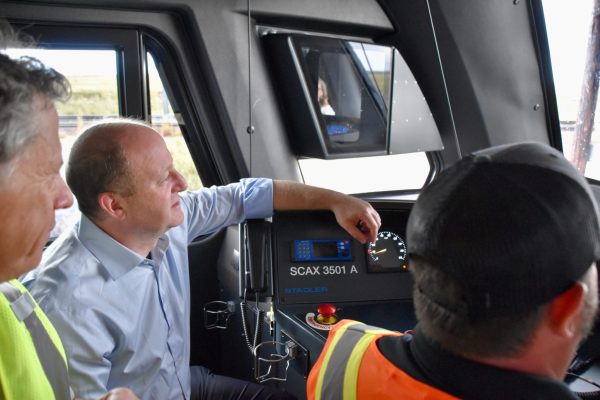Colorado’s Front Range Passenger Rail sales tax vote pushed off until 2026 for planning purposes

Gov. Jared Polis sits in the cab of a hydrogen-powered train on the test track at the Transportation Technology Center in Pueblo on Sept. 19, 2023 (Chase Woodruff/Colorado Newsline).
Board members overseeing Colorado’s efforts to restore intercity passenger rail service along the Front Range signaled this week that they plan to wait until 2026 to ask voters to fund the project with a small sales tax increase, forgoing the chance to put the measure on this November’s ballot.
A final decision on the timing of a forthcoming ballot measure will be made by the Front Range Passenger Rail District’s 17-member board of directors at its May 31 meeting, concluding months of deliberations, financial modeling and multiple rounds of public opinion polling conducted in advance of a potential 2024 ballot referral.
But during a meeting of the board’s executive committee on Tuesday, chair Chris Nevitt said that after “a complicated conversation with members of the board (and) with the governor’s office,” FRPR leadership wants to hit the brakes on a ballot measure.
“The best course of action is to step into 2026 as the intent of the board, to go to the voters with a more complete package,” said Nevitt, a transportation manager for the City and County of Denver.
Created by the Legislature in 2021, the FRPR board is made up of appointees from communities across the district, which encompasses all or part of 13 counties along the Interstate 25 corridor. Momentum behind the decades-in-the-making proposal has surged since the passage of billions in new funding for passenger rail as part of the 2021 federal infrastructure law, and Democratic Gov. Jared Polis and top lawmakers have made the project a showpiece in their push for higher-density housing and transit-oriented communities in Front Range cities.
Legislation signed into law by Polis last week will direct tens of millions of dollars in state revenue to supplement those efforts and help secure federal grants, while the bulk of the funding to build and operate the new service would likely come from a district-wide sales tax hike of around 0.2%. The total price tag for the service could range from $2 billion to $6 billion, district officials have said.
Polling conducted earlier this year for the district showed strong support for a sales tax hike — even for a much higher increase of 0.5%, which earned support from 61% of prospective voters compared to 34% opposed. But at the request of Polis’ office, the board in March and April put off a decision on ballot timing and opted instead to conduct a second round of polling in order to “truth-test,” in Nevitt’s words, those findings.
In explaining his preference for a 2026 ballot measure on Tuesday, Nevitt called public support for FRPR “strong and widespread” but implied that the results of the follow-up poll, which are not yet public, factored into the likely delay.
“It seems that at this moment, there are questions that we don’t have perfect answers to,” he said. “There’s some concern with respect to how much challenge people’s opinions could take.”
Board members also said a 2026 vote would allow district staff to complete work on a service development plan, which will detail the route, stations, frequency and other service details of the proposed line. And even in the absence of sales tax funding, the state’s new revenue streams for rail and transit projects will allow it to compete effectively for federal grants over the next two years, said John Putnam, a senior advisor for the Colorado Department of Transportation.
State officials have thrown their weight behind a plan to establish a “starter service” of several trains per day operating between Fort Collins and Denver before 2030 — a hybrid of sorts between FRPR and the Regional Transportation District’s long-delayed B Line to Boulder and Longmont. By qualifying for federal intercity rail funding, such a service — which could be formally operated by the FRPR district, RTD or a “separate legal entity” — could serve as a catalyst for the completion of both Front Range rail and the B Line within the shared corridor.
“Having gone through some of the financial modeling exercises, I think we have a much better idea of what it will take to build this project,” Putnam said. “I think through the process laid out in Senate Bill (24-)184, we’ll make progress in actually taking down some of those grants and taking down the cost to deliver the whole corridor.”
“We’ve been sprinting with the the possibility of going to the ballot as early as 2024,” Nevitt said. “We did know all along that we were sprinting, and we didn’t have all the answers. And I think the extra time will help us in that regard, and be able to deliver a better, more complete product to the voters in 2026.”
Editor’s note: This story first appeared on Colorado Newsline, which is part of States Newsroom, a nonprofit news network supported by grants and a coalition of donors as a 501c(3) public charity. Colorado Newsline maintains editorial independence. Contact Editor Quentin Young for questions: info@coloradonewsline.com. Follow Colorado Newsline on Facebook and Twitter.
Chase Woodruff
Latest posts by Chase Woodruff (see all)
- Colorado-Utah battle over oil trains could wind up tied in U.S. Supreme Court following recusal - December 12, 2024
- Colorado’s Front Range Passenger Rail sales tax vote pushed off until 2026 for planning purposes - May 23, 2024
- Colorado officials cite relentless threats, election lies in wake of SCOTUS ruling on Trump eligibility - March 5, 2024

You must be logged in to post a comment Login